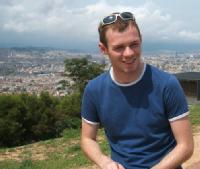Stephen Hogg
"Pulsed electrically detected magnetic resonance: hardware optimisation and high microwave frequency implementation"
Hello and welcome to my page. I am currently undertaking a PhD at the University of Dundee under the supervision of Dr David Keeble. I graduated from Dundee in 2011 with an MSci Physics degree.
My experience with magnetic resonance begun in the penultimate year of my undergraduate degree when I began a two year research programme to understand electron paramagnetic resonance (EPR) and apply it to the study of magnetic impurity ions in ferroelectric single-crystals. The first year of the project consisted of gaining experience with the equipment and techniques, working on standardised samples and investigating the theory involved. The second year proceeded to focus on a single-crystal sample of PbTiO3:Mn4+ taking detailed spectra to investigate the anisotropy of the defect structure.
Following on from knowledge gained at undergraduate level, my PhD project centres around the related technique of electrically detected magnetic resonance (EDMR) where instead of detecting the reflected microwave power as in EPR the magnetic resonance is observed as a change in a transport current through the sample. Specifically, the research will involve optimising the detection of both continuous wave and pulsed EDMR from different types of materials systems, for example amorphous and crystalline silicon, organic semiconductor devices, etc. This will involve optimisation of the experimental arrangement, for example the amplifier type and characteristics, driving voltages or currents, etc. These are expected to vary dependent on the electrical properties of the devices to be studied and whether cw or pulsed measurements are performed. It is also planned to extend these measurements from 9.5 GHz to higher microwave frequencies (34 GHz, and 95 GHz). The latter will make use of the higher power pulsed spectrometer at St Andrews, HiPER.
Currently, my work involves preparing stable test ‘devices’ to benchmark EDMR measurements. Samples are being fabricated from crystalline phosphorous doped silicon and from a-Si:H, additional samples for EPR characterisation are also being prepared. EDMR signals involving 31P centres are expected from Si:P and from Pb (Si dangling bond) centres in the a-Si:H.
